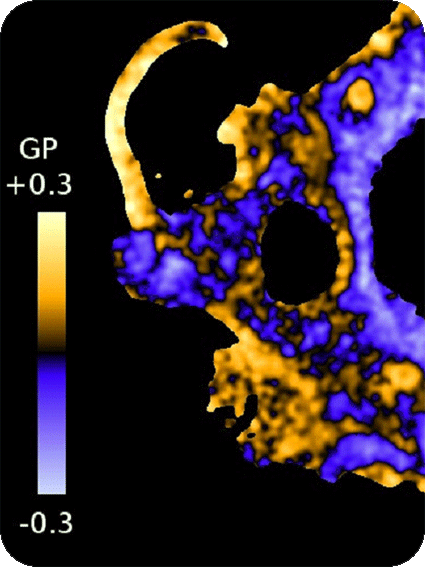Laboratory of Bacterial Physiology
Head:
doc. RNDr. Radovan Fišer, Ph.D.
Department of Genetics and Microbiology
Study consultant and guarantor of M.Sc. study programme Microbiology, as well as Ph.D. study programme Microbiology
Viničná 5, 2NP, room 103
Viničná 5, 2NP, room 104
Where to Find Us:
Viničná 5, Prague 2 - New Town, 128 43
the first floor (rooms 101, 103, 104, 104a, 104b, 104c, 110, 124), the basement (rooms S11, S11a, S11b)
Team MembersMethodology and Technical SupportScientific CollaborationsPublications |
TeachingProposed Topics of Theses for New StudentsStudent Theses in ProgressPast Student Theses |
Research Interests
Further information can be also found at the http://web.natur.cuni.cz/~konop/contact.php website
 The Laboratory of Bacterial Physiology focuses on the function of bacterial toxins that act on the cytoplasmic membrane of target cells. Additionally, it studies the adaptation of bacterial membranes to stress, their interactions with surfactants, and the interaction of bacterial cells with nanomaterials. The group employs a wide range of biophysical methods alongside traditional microbiological approaches: techniques based on fluorescence spectroscopy and microscopy, conductance measurements on lipid bilayers, X-ray structural analysis, analytical chemistry methods (gas and liquid chromatography), and computational methods for protein structure determination.
The Laboratory of Bacterial Physiology focuses on the function of bacterial toxins that act on the cytoplasmic membrane of target cells. Additionally, it studies the adaptation of bacterial membranes to stress, their interactions with surfactants, and the interaction of bacterial cells with nanomaterials. The group employs a wide range of biophysical methods alongside traditional microbiological approaches: techniques based on fluorescence spectroscopy and microscopy, conductance measurements on lipid bilayers, X-ray structural analysis, analytical chemistry methods (gas and liquid chromatography), and computational methods for protein structure determination.
 Bacteria export toxins into their surroundings, which can drastically alter the behavior of target cells and lead to their death. The Laboratory studies protein toxins from pathogenic bacteria and their interactions with the membranes of host target cells. It has a long-standing focus on the adenylate cyclase RTX toxin (CyaA) of Bordetella pertussis, the causative agent of whooping cough. The CyaA toxin inhibits the immune response of target cells through its activities. In collaboration with the Laboratory of Molecular Biology of Bacterial Pathogens (Institute of Microbiology of the Czech Academy of Sciences), led by Prof. Peter Šebo, Ph.D., the Laboratory has succeeded in proposing a model of CyaA interaction with the membrane of infected cells, explaining the significance of calcium influx and potassium efflux from target cells, and mapping the fate of the toxin after its entry into membrane rafts and phagocytes. Our group also contributes to research on the 3D structure of the C-terminal RTX domain of CyaA and other related RTX toxins, which is crucial for their correct conformation. The findings on the CyaA toxin could have practical applications in human medicine. The modified toxin can deliver antigens derived from viruses, bacteria, and parasites into immune system cells, inducing an immune response. An optimally modified CyaA toxin, stripped of its enzymatic activities, will be part of a newly developed subunit vaccine against whooping cough, whose incidence is alarmingly rising in developed countries.
Bacteria export toxins into their surroundings, which can drastically alter the behavior of target cells and lead to their death. The Laboratory studies protein toxins from pathogenic bacteria and their interactions with the membranes of host target cells. It has a long-standing focus on the adenylate cyclase RTX toxin (CyaA) of Bordetella pertussis, the causative agent of whooping cough. The CyaA toxin inhibits the immune response of target cells through its activities. In collaboration with the Laboratory of Molecular Biology of Bacterial Pathogens (Institute of Microbiology of the Czech Academy of Sciences), led by Prof. Peter Šebo, Ph.D., the Laboratory has succeeded in proposing a model of CyaA interaction with the membrane of infected cells, explaining the significance of calcium influx and potassium efflux from target cells, and mapping the fate of the toxin after its entry into membrane rafts and phagocytes. Our group also contributes to research on the 3D structure of the C-terminal RTX domain of CyaA and other related RTX toxins, which is crucial for their correct conformation. The findings on the CyaA toxin could have practical applications in human medicine. The modified toxin can deliver antigens derived from viruses, bacteria, and parasites into immune system cells, inducing an immune response. An optimally modified CyaA toxin, stripped of its enzymatic activities, will be part of a newly developed subunit vaccine against whooping cough, whose incidence is alarmingly rising in developed countries.
Unlike pathogenic bacterial toxins that inhibit host functions, the goal of other protein toxins - colicins of enterobacteria - is to kill closely related surrounding bacteria. In colicin research, our group, in collaboration with the Laboratory of Bacterial Genetics and Genomics (Faculty of Medicine, Masaryk University, Brno), led by Prof. David Šmajs, Ph.D., has demonstrated pore-forming characteristics in selected newly discovered enterobacterial colicins.
 Bacteria are excellent model organisms that respond quickly and efficiently to changes in environmental conditions. Changes in membrane composition, altering its fluidity, charge, and other physical properties, are a very common consequence of this adaptation. The bacterial membrane is also a target for antibiotics that has yet to be fully exploited. The Laboratory has been studying various stress adaptations in the model soil bacterium Bacillus subtilis over the long term - examples include the adaptation of B. subtilis membrane composition triggered by its own production of the lipopeptide antibiotic surfactin, and research into surfactin's interaction with the membrane itself. Surfactin is a promising candidate for future clinical use, but its mechanism of action and the mechanism of resistance of its producer to this membrane-active molecule are still unresolved. In addition to other stresses, the cold adaptation of B. subtilis is also being studied, including the role of membrane fatty acid desaturase, as well as the cold adaptation of Bordetella species in connection with the induction of virulence factors upon host entry.
Bacteria are excellent model organisms that respond quickly and efficiently to changes in environmental conditions. Changes in membrane composition, altering its fluidity, charge, and other physical properties, are a very common consequence of this adaptation. The bacterial membrane is also a target for antibiotics that has yet to be fully exploited. The Laboratory has been studying various stress adaptations in the model soil bacterium Bacillus subtilis over the long term - examples include the adaptation of B. subtilis membrane composition triggered by its own production of the lipopeptide antibiotic surfactin, and research into surfactin's interaction with the membrane itself. Surfactin is a promising candidate for future clinical use, but its mechanism of action and the mechanism of resistance of its producer to this membrane-active molecule are still unresolved. In addition to other stresses, the cold adaptation of B. subtilis is also being studied, including the role of membrane fatty acid desaturase, as well as the cold adaptation of Bordetella species in connection with the induction of virulence factors upon host entry.
Nanomaterials of various compositions are increasingly used in biomedical applications today, such as for surface modification of implants, drug delivery into the organism, or as substrates in tissue engineering. New nanomaterials are often developed to achieve an optimal combination of opposing properties - biocompatibility with eukaryotic cells and, conversely, surface properties that prevent the growth of contaminating microorganisms, i.e., anti-adhesive and antibacterial surface characteristics. The advantage of carbon nanomaterials, which our group also studies, is their potential for functionalization, where their properties can be altered by attaching functional groups to carbon atoms. In close collaboration with the Diamond Growth Research Group (Department of Semiconductors, Institute of Physics of the Czech Academy of Sciences), led by Alexander Kromka, Ph.D., D.Sc., our group researches the antibacterial properties of carbon nanomaterials and their mechanism of action on model bacteria. Other materials currently being studied for their antibacterial properties include nanocomposite coatings based on nanosilver and plasma polymers, whose production and research are carried out by the group led by Assoc. Prof. Ondřej Kylián, Ph.D., in the Department of Macromolecular Physics at the Faculty of Mathematics and Physics, Charles University.





















